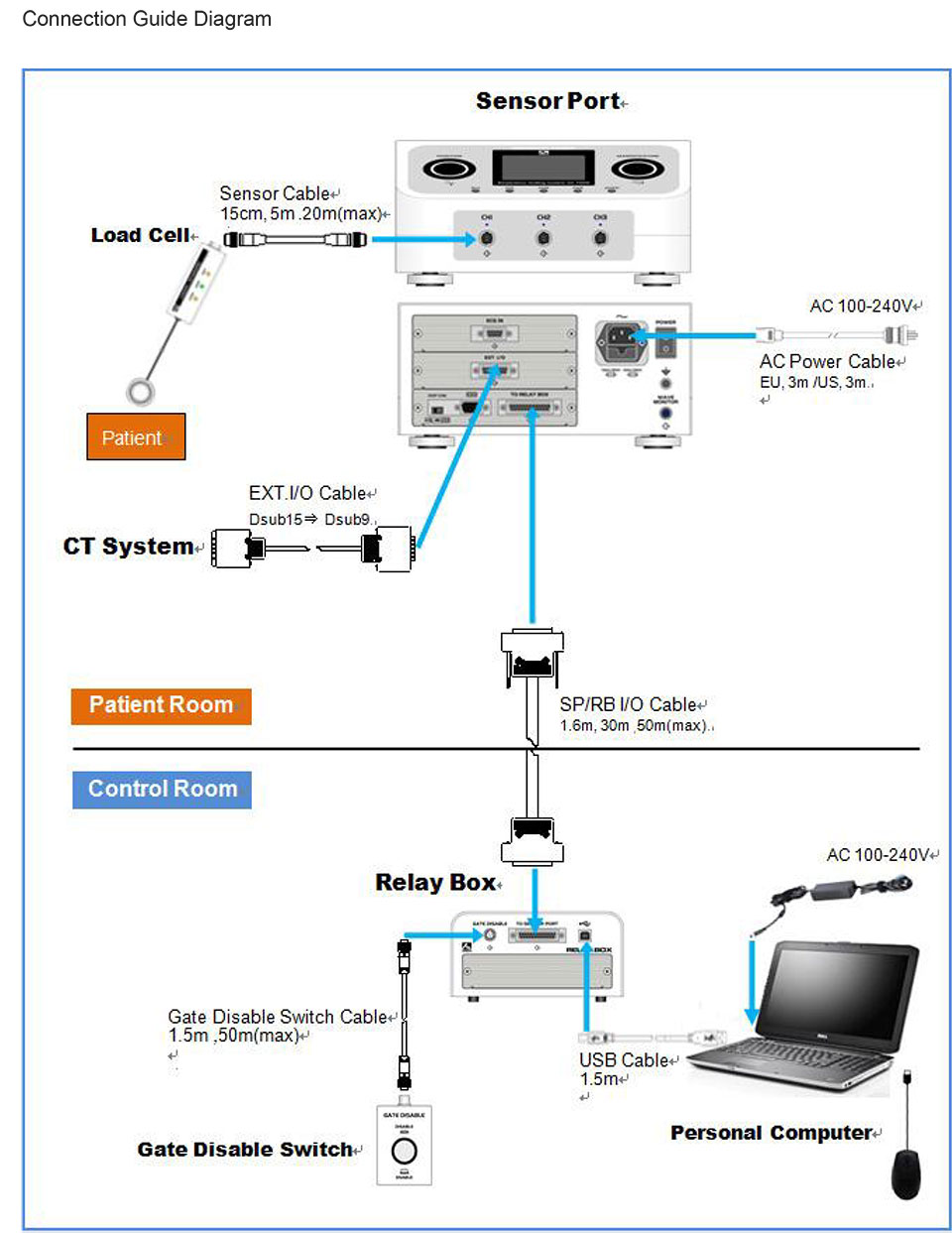PRODUCT

Product Overview
-
What is respiratory gating?
The problem with performing image diagnosis and radiotherapy of tumors arising in organs affected by respiratory motion such as the lungs and liver is that the position of the tumor moves due to the patient’s breathing during imaging or radiotherapy.
These respiratory movements may cause the resolution of the captured image artifacts occur. And the result it may affect the diagnosis. In addition, during radiation therapy, there is concern that the efficacy will be reduced as the tumor may not receive a sufficient dose of radiation, and that surrounding healthy tissue will be irradiated instead, resulting in the side effect of undesirable radiation damage. It is known that steady breathing can be approximated by periodic repetitive movements. With this knowledge, it is possible to take advantage of specific respiration states (e.g. maximum inhalation, complete exhalation, etc.). If imaging or irradiation is performed only in the stationary periods between respiration states, it is possible to achieve high-precision imaging and radiation therapy without the negative effects of respiratory motion. In this way, the respiratory gating system is a medical device that performs respiratory gating imaging and respiratory gating irradiation in accordance with respiratory motion. The respiration gating system uses a sensor to detect a signal representing the respiration state, creates a respiration signal (or a respiratory signal that is synchronized with the respiration signal), and supplies it to a diagnostic imaging or radiotherapy device. These diagnostic imaging and radiotherapy devices perform respiratory synchronized imaging and irradiation by performing imaging and irradiation in concordance with the respiratory signal or respiratory signal. Currently, respiratory gating systems are commonly used alongside CT devices are to record 4D-CT image throughout the entire respiratory cycle of a patient. This image is then used to create a treatment plan for the patient’s radiation therapy.
-
What is Anzai Medical’s Respiratory Gating System?
It has been a quarter of a century since the world’s first respiratory gating system was developed by ANZAI in collaboration with Tsukuba University Hospital in 1987. In the years since, Anzai Medical has perfected our Respiratory Gating System AZ-733VI.
In response to demand for faster respiratory gating systems in the radiotherapy field, ANZAI has achieved a respiratory signal output delay of 50 ms or less between detection of respiratory signals and respiratory signal output. As a breathing sensor, in addition to the load cell (contact) that has been standard component; we have prepared a laser sensor option (non-contact) to flexibly respond to various requests in the medical field. Also included is the functionality to connect to and acquire the signals of 3 respiration sensors at the same time. Functionally enhanced is the ability to check and adjust all parts of the respiration sensor on the patient from a nearby port, greatly reducing the time required for a previously laborious process. In addition to various safety functions inherited and enhanced from the previous model AZ-733V, the sophisticated user interface on the AZ-733VI’s personal computer screen enables intuitive operation and provides the ability to pre-check settings to prevent erroneous operation. In addition, a gate disable switch is equipped as standard to respond immediately to sudden changes in the patient’s breathing condition. In order to flexibly support connection with external devices such as diagnostic imaging and radiotherapy equipment, up to three interface boards are mounted on the AZ-733VI (two on the sensor port and one on the relay box). The gate signal is output to only one device which is selected on the personal computer screen. A wide range of external devices are compatible in combination with various respiratory signal output modes further enhanced from the previous model AZ-733V.
-
Compatible devices
More than 2000 units Anzai Medical’s respiratory gating system AZ-733VI have been shipped to all over the world. And it can be used in combination with the radiotherapy equipment and diagnostic imaging equipment of the following companies.

-
Download the Product Overview
For detailed information, please click on the link below directly
-
High Performance
Respiratory Gating System AZ-733VI has devolved the basic performance required for a respiratory synchronization device.
Respiratory sensor to be used according to modality
Two types of high-accuracy respiratory sensors can be used according to the modality to be combined.
Loadcell Sensor (patient contact style)
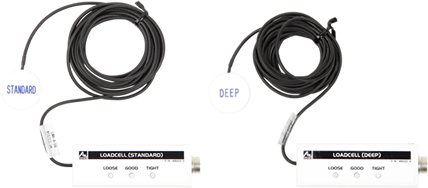
It is a sensor that detects pressure with a strain gauge. By attaching the sensor to the patient with a belt, the movement of the body surface (change in abdominal pressure) due to respiratory movement is displayed as a respiratory waveform. “DEEP” and “STANDARD” are used according to the size of the abdominal movement. “STANDRAD” is used for standard movements, and “DEEP” is used for large movements. As a modality to be combined, it is ideal for PET-CT devices that allow patients to enter deep inside the gantry.
Laser Sensor (patient non-contact style)
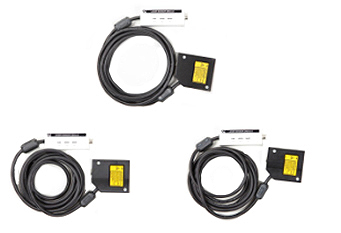
It is a sensor that measures the reflection of laser light (infrared). A laser beam is applied to the patient’s skin and the movement of the body surface (displacement amount to the sensor) due to respiratory movement is displayed as a respiratory waveform. We have three types of 250mm, 120mm, and 85mm depending on the focal length of the laser. This sensor, which does not come into contact with the patient, is best suited as a modality to be combined with radiation therapy equipment.
Reduced delay time

High-speed gate mode: within 25 msec Normal gate mode: Within 50 msec
Respiratory gating system is used in combination with radiotherapy equipment and image diagnostic equipment. The biggest subject to reduce the performance for modalities being combined was to reduce latency. Compared to conventional equipment, the speed is reduced to 1/4 in high-speed gate mode and 1/2 in normal gate mode. This makes it possible to realize more accurate radiation treatment and image diagnosis than ever before. The delay time is the time from when the sensor detects the movement of the body surface due to respiratory movement until the gate signal is output.
-
Scalability
Respiratory gating system AZ-733VI has new functions and connections that have never been seen before.
Excellent cost performance
Conventionally, one external device was connected to one device, but AZ-733VI can connect up to three types of external devices to one device. This allows the same respiratory synchronization system to be used when migrating from simulated CT to treatment, enabling low budget implementation.
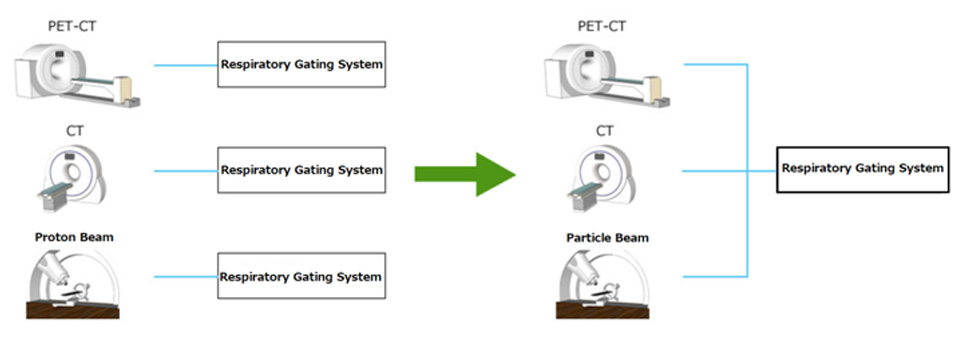
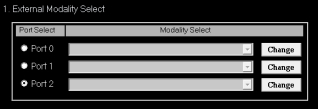
Select the device to output the gate signal on the software. *Note that the gate signals cannot be output simultaneously.
Using multiple sensors
Respiratory gating system AZ-733VI can use up to 3 respiratory sensors simultaneously. Since the movement to the body surface due to respiratory movements differs depending on the patient, it is possible to capture respiratory information from multiple locations and perform respiratory gating at the most stable location.
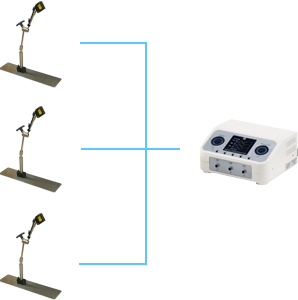
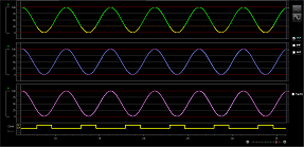
Respiratory waveform 3 typesOutput of ECG/breath gating signals
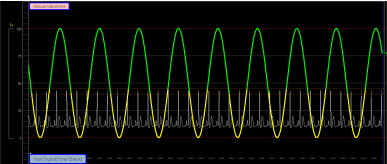
Respiratory gating system AZ-733VI has a function to output an electrocardiographic/respiratory gating signal by connecting an electrocardiograph. When the arbitrarily set respiratory gating signal and electrocardiographic gating signal overlap, the electrocardiogram/respiratory gating signal is output to an external device.
-
Convenience
By improving operability and fulfilling file management, we aimed to create an application that will satisfy users all over the world.
Easy respiratory waveform adjustment
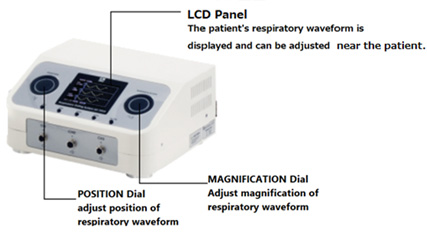
By operating the rotary encoder mounted on the sensor port, the respiratory waveform can be adjusted near the patient. It is no longer necessary to return to the operation room and adjust the waveform from the software after installing the sensor as in the past. In addition, the waveform is displayed on the LCD screen of the sensor port, which improves reproducibility when mounting the sensor.
Extensive patient data management
In addition to saving and replaying the saved patient data, the respiratory information is displayed in time series to facilitate understanding of the patient’s respiratory characteristics, and a histogram is displayed by aggregating by respiratory level or respiratory rate.
Table display of patient data
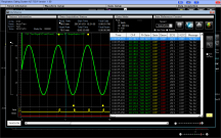
Histogram display of patient data
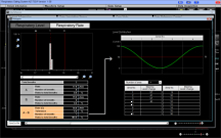
-
Efficiency
The efficiency of respiratory gating (short-time treatment/ photographing) reduces the burden on patients.
Addition of new gate output mode
A new “Level to Level” mode, which is mainly used for radiation therapy, has been added. The gate signal is output to an external device by deciding the phase that is less affected (moved) by the respiratory phase. Since the gate signal is output within the set level regardless of expiration or inspiration, breath-hold irradiation is also possible.

The above outputs the gate signal at Level 20-60, and two gate signals are output during one respiratory cycle.Addition of breath monitor

Respiratory gating is a treatment/imaging that depends on the patient’s respiratory condition. We have prepared a respiratory monitor so that the patient can see the respiratory waveform and consciously breathe. It is hoped that the patient’s breathing condition will be stable and the treatment/diagnosis time will be shortened.
-
Safty Function
It is available to use Respiratory Gating System AZ-733VI safely with its various safety functions.
Stop gate signal in case of emergency
In an emergency, you can use the gate cutoff switch to forcibly stop the gate signal output.

Abnormal breath detection
When the following breathing abnormalities are detected, an error message is displayed on the software and the gate output to the external device is stopped.
1.Detection of abnormal breathing due to sneezing or body movement
2.Detection of abnormal breathing rate
3.Breath arrest detection
4.Abnormal exhalation peak detection
5.Intake peak abnormality detection
6.Detection of abnormalities in mean breathing
-
Data Download
For detailed information, please click on the link below directly
-
Minimize the radiation target area and reduce radiation damage to normal tissues and organs
When we plan radiation therapy on large-aperture CT, almost all chest tumors, hepatobiliary tumors move with breathing during treatment. The patient's respiratory movement causes the tumor location and vital organs to move, resulting in insufficient radiation dose to the tumor target area, or high dose radiation to vital organs, resulting in radiation pneumonia, hepatitis and other diseases. Respiratory gating technology can be used to compensate respiratory movement, which can accurately outline the position of radiotherapy target, minimize the area of radiotherapy target, and effectively control the influence of respiratory movement on tumor target, so as to achieve accurate treatment and reduce radiation damage to normal tissues and organs.
-
Realize 4D-CT function
Large aperture CT combined with respiratory gating can effectively reduce the X-ray dose of patients when taking pictures, and the 4D image of the thoracoabdominal organs or tumors can be observed at any time on CT, as well as the tumor position at any breathing phase. The range of motion of the tumor can be accurately located, which is conducive to the delineation of the radiotherapy target. In addition, it can also correct the blurring of CT images caused by breathing movement and improve the resolution.
- Clinical Literature
For more clinical literature, please click the link below.
-
Which delivers greater accuracy, load cells or laser sensors?
There is no difference in sensitivity between the two, so please use that which suits your purposes. Load cells, which are affixed directly to a patient’s body, are suitable for use with PET-CT machines with a deep gantry. Non-contact laser sensors, which are not directly affixed to a patient, are suitable for use in radiation therapy and with fixed equipment.
-
What is the difference between “standard” and “deep” load cells?
Standard load cells offer higher sensitivity, while deep load cells provide a greater range of measurement. Furthermore, standard load cells are used for patients with relatively small respiratory motions. Deep load cells are used for patients with larger respiratory motions.
-
There is no test waveform output.
“TEST SIGNAL” must be enabled in the software settings. All components (sensors, etc.) must also be connected. If “Test Signal” is displayed in the center of the application screen but the test waveform is not displayed, adjust the Magnification/Position.
-
How can I connect multiple external devices to the AZ-733VI system?
You will need to add a dedicated cable and interface for each connected device. Connection cables may be added as needed.
-
What type of cables should be used?
Please refer to the connection guide below.
